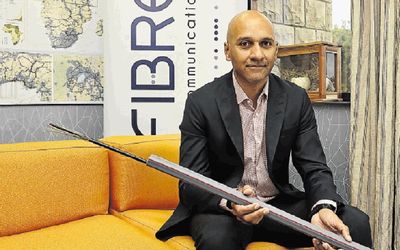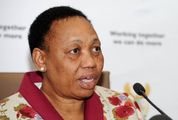NOW that we know the "ether" is not an actual thing, exactly how are e-mails, downloads and data sent and received? For those content to remain ignorant about the brave new digital world, the reality is comfortingly tangible.
"If you send an e-mail, say to an overseas recipient, what physically happens is that it goes from your desk to a data centre that may be in your building, from there to a data centre that may be in Joburg, then down to one at the coast; from there it goes typically to London, and from there to somewhere else. It is physically moving; the data has to go somewhere!" says FibreCo CEO Arif Hussain.
FibreCo owns and operates a nationwide, 2,400km long-haul fibre-optic network that connects Johannesburg and Cape Town, Bloemfontein and East London. Founded in 2009 as a joint venture with Convergence Partners, Dimension Data and Cell C, the company started the build in early 2012.
"We switched on the network at the end of 2013. We built 1,000km in 14 months which, from a construction point of view, is streets ahead of the curve. Through commercial negotiations we acquired another 1,400km and put it all together," Hussain says.
The largest cost, and thus the greatest barrier to entry for service providers that don’t have their own fibre-optics infrastructure, is the cost of civil works.
"All our cables are subterranean. This offers a higher quality of service, we believe, and offers reliability.
"We also built in scalability by putting in spare ducts to be used as new clients require access to our infrastructure, which means we don’t have to dig any more holes — which can be quite disruptive. There is also angst about duplication of infrastructure for the country, and rightly so; it’s inefficient from both an economic and environmental point of view."
Hussain has an honours degree in civil engineering but, before the ink on that certificate was dry, he went on to get a master of philosophy in management studies and became a chartered accountant.
In contrast to the "if you build it, they will connect" approach, before any digging started, FibreCo got the buy-in from customers who would enjoy its open access and customised management without shouldering any of the build burden.
"I have been in charge of the project from inception, but I can’t take the credit for the initial investment proposal; it was our chairman, Andile Ngcaba’s idea — scribbled on the back of a napkin," Hussain says.
The network was built on a project financing model, which meant that identifying and mitigating risks contractually, and managing the project within these constraints all the way to completion, was all undertaken by FibreCo. One of the earliest "anchor clients" to sign up to the project was international ICT giant BT Global, which has been operating in SA for 24 years.
"It was a no-brainer," says BT Global’s MD for sub-Saharan Africa, Oliver Fortuin.
"FibreCo was offering an open-access platform, and the quality of the network and our control over it are fundamental to the services we can provide.
"It made complete commercial sense to run with FibreCo laying a high-capacity, long-haul network between major centres in the country, especially with infrastructure in SA and Africa in general being so underinvested. It meant there was very little risk for us."
...
BESIDES concentrating on long-haul infrastructure rather than within metros, what sets FibreCo apart is its open-access network and rigorous service level agreements (SLAs). Open access means anybody can put their own equipment on the network, or portions can be allocated to specific service providers. This is a vastly different model from other service providers.
"Open-access infrastructure is prevalent in Europe — it’s part of a long and important road if you want the digital economy to flourish," says Fortuin. "Companies such as Google would simply never have got off the ground if the infrastructure costs had been too high. Currently, at a consumer level, we are paying up to 50 times more for broadband here than in western Europe. The roll-out of more open-access infrastructure will see those figures coming down."
...
FORTUIN emphasises that sensible regulation regarding open-access infrastructure is required to ensure that monopoly infrastructure, as existed in the past with Telkom, is either minimised or "eliminated altogether".
"The downside of monopoly infrastructure is high costs and poor service delivery. Open access addresses both these issues while promoting innovation in service provisioning, as this can then become the differentiator."
FibreCo is "ultimately a privately funded, for-profit, independent infrastructure builder", says Hussain, "but it’s pretty clear that we fulfil a very developmental function too, by putting in infrastructure that helps the whole market benefit, and the country, and that includes feeding into the government’s SA Connect policy."
Hussain would like clarity on the implementation of the policy. In his last state of the nation address, President Jacob Zuma said that Telkom was going to be "the champion" of the initiative.
"I’m not sure where that leaves people like us," says Hussain, albeit without rancour; FibreCo works closely with the government as a regulator and permit provider.
"We’ve built infrastructure — not into schools or public space or police stations, as expected with the SA Connect policy, but then nor has Telkom — but we have the backbone running through provinces to link that final, say 50km, to smaller towns and public institutions in them. We would like the opportunity to have some of that work rather than it all going back to Telkom."
...
HUSSAIN says every kilometre of its 2,400km network has the same service level agreement. "We have no leeway; if it breaks anywhere, that portion of the network enjoys the same response time.
"For us to have a national presence we need a skilled pool of technicians around the country, within a certain driving distance, as we have a response time of no more than two hours on site, and very strict reporting timelines to restore any part of the network, which is part of every service level agreement.
"There are a lot of skilled people in Gauteng, despite … a shortage, but in the smaller centres we need people on the phone with clients, such as BT, who offer the same skills regardless of region or the size of their end user.
"We maintain all the fibre-optics, but there are mini data centres dotted every 60km-80km along the route, in which our customers have equipment which we look after too.
"Some of our networks are negotiated with third parties, but we deliver an SLA across it all and manage it as a single network. This takes a lot of pain away from a lot of people’s businesses. For instance, BT has their customer network centre in Europe; their guys in Europe talk to our guys here and co-ordinate what’s happening on the ground."

Arif Hussain, CEO of FibreCo at the telecoms company’s Woodmead head office. The largest cost in bringing better broadband to SA is that of the civil works needed. Picture: FREDDY MAVUNDA
NOW that we know the "ether" is not an actual thing, exactly how are e-mails, downloads and data sent and received? For those content to remain ignorant about the brave new digital world, the reality is comfortingly tangible.
"If you send an e-mail, say to an overseas recipient, what physically happens is that it goes from your desk to a data centre that may be in your building, from there to a data centre that may be in Joburg, then down to one at the coast; from there it goes typically to London, and from there to somewhere else. It is physically moving; the data has to go somewhere!" says FibreCo CEO Arif Hussain.
FibreCo owns and operates a nationwide, 2,400km long-haul fibre-optic network that connects Johannesburg and Cape Town, Bloemfontein and East London. Founded in 2009 as a joint venture with Convergence Partners, Dimension Data and Cell C, the company started the build in early 2012.
"We switched on the network at the end of 2013. We built 1,000km in 14 months which, from a construction point of view, is streets ahead of the curve. Through commercial negotiations we acquired another 1,400km and put it all together," Hussain says.
The largest cost, and thus the greatest barrier to entry for service providers that don’t have their own fibre-optics infrastructure, is the cost of civil works.
"All our cables are subterranean. This offers a higher quality of service, we believe, and offers reliability.
"We also built in scalability by putting in spare ducts to be used as new clients require access to our infrastructure, which means we don’t have to dig any more holes — which can be quite disruptive. There is also angst about duplication of infrastructure for the country, and rightly so; it’s inefficient from both an economic and environmental point of view."
Hussain has an honours degree in civil engineering but, before the ink on that certificate was dry, he went on to get a master of philosophy in management studies and became a chartered accountant.
In contrast to the "if you build it, they will connect" approach, before any digging started, FibreCo got the buy-in from customers who would enjoy its open access and customised management without shouldering any of the build burden.
"I have been in charge of the project from inception, but I can’t take the credit for the initial investment proposal; it was our chairman, Andile Ngcaba’s idea — scribbled on the back of a napkin," Hussain says.
The network was built on a project financing model, which meant that identifying and mitigating risks contractually, and managing the project within these constraints all the way to completion, was all undertaken by FibreCo. One of the earliest "anchor clients" to sign up to the project was international ICT giant BT Global, which has been operating in SA for 24 years.
"It was a no-brainer," says BT Global’s MD for sub-Saharan Africa, Oliver Fortuin.
"FibreCo was offering an open-access platform, and the quality of the network and our control over it are fundamental to the services we can provide.
"It made complete commercial sense to run with FibreCo laying a high-capacity, long-haul network between major centres in the country, especially with infrastructure in SA and Africa in general being so underinvested. It meant there was very little risk for us."
...
BESIDES concentrating on long-haul infrastructure rather than within metros, what sets FibreCo apart is its open-access network and rigorous service level agreements (SLAs). Open access means anybody can put their own equipment on the network, or portions can be allocated to specific service providers. This is a vastly different model from other service providers.
"Open-access infrastructure is prevalent in Europe — it’s part of a long and important road if you want the digital economy to flourish," says Fortuin. "Companies such as Google would simply never have got off the ground if the infrastructure costs had been too high. Currently, at a consumer level, we are paying up to 50 times more for broadband here than in western Europe. The roll-out of more open-access infrastructure will see those figures coming down."
...
FORTUIN emphasises that sensible regulation regarding open-access infrastructure is required to ensure that monopoly infrastructure, as existed in the past with Telkom, is either minimised or "eliminated altogether".
"The downside of monopoly infrastructure is high costs and poor service delivery. Open access addresses both these issues while promoting innovation in service provisioning, as this can then become the differentiator."
FibreCo is "ultimately a privately funded, for-profit, independent infrastructure builder", says Hussain, "but it’s pretty clear that we fulfil a very developmental function too, by putting in infrastructure that helps the whole market benefit, and the country, and that includes feeding into the government’s SA Connect policy."
Hussain would like clarity on the implementation of the policy. In his last state of the nation address, President Jacob Zuma said that Telkom was going to be "the champion" of the initiative.
"I’m not sure where that leaves people like us," says Hussain, albeit without rancour; FibreCo works closely with the government as a regulator and permit provider.
"We’ve built infrastructure — not into schools or public space or police stations, as expected with the SA Connect policy, but then nor has Telkom — but we have the backbone running through provinces to link that final, say 50km, to smaller towns and public institutions in them. We would like the opportunity to have some of that work rather than it all going back to Telkom."
...
HUSSAIN says every kilometre of its 2,400km network has the same service level agreement. "We have no leeway; if it breaks anywhere, that portion of the network enjoys the same response time.
"For us to have a national presence we need a skilled pool of technicians around the country, within a certain driving distance, as we have a response time of no more than two hours on site, and very strict reporting timelines to restore any part of the network, which is part of every service level agreement.
"There are a lot of skilled people in Gauteng, despite … a shortage, but in the smaller centres we need people on the phone with clients, such as BT, who offer the same skills regardless of region or the size of their end user.
"We maintain all the fibre-optics, but there are mini data centres dotted every 60km-80km along the route, in which our customers have equipment which we look after too.
"Some of our networks are negotiated with third parties, but we deliver an SLA across it all and manage it as a single network. This takes a lot of pain away from a lot of people’s businesses. For instance, BT has their customer network centre in Europe; their guys in Europe talk to our guys here and co-ordinate what’s happening on the ground."




















Change: -0.47%
Change: -0.57%
Change: -1.76%
Change: -0.34%
Change: 0.02%
Data supplied by Profile Data
Change: -1.49%
Change: 0.08%
Change: -0.47%
Change: 0.00%
Change: -0.04%
Data supplied by Profile Data
Change: -0.34%
Change: 0.03%
Change: -0.10%
Change: -0.22%
Change: -0.81%
Data supplied by Profile Data
Change: -0.28%
Change: -1.15%
Change: -0.07%
Change: -1.21%
Change: -0.22%
Data supplied by Profile Data